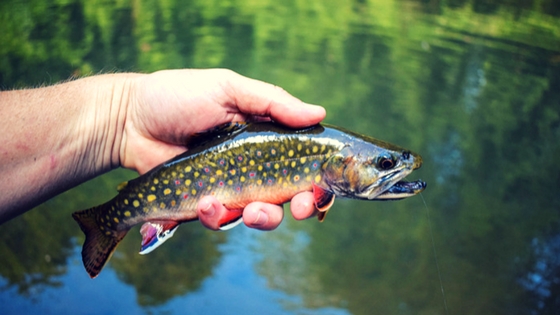Brook Trout Summer Fishing

 set up a River Trout Float Rig for best fishing (see ‘how to’ below)
set up a River Trout Float Rig for best fishing (see ‘how to’ below)
Summer fishing techniques vary depending if you’re fishing in the northern range of the Brook Trout’s habitat or in the southern range of their habitat.
Summer Fishing Techniques – depends where you are
Fishing in the southern portions of their distribution in summer, deep water fishing techniques or Lake Techniques will work much better on Brook Trout. (This area ranges from central Ontario and Quebec south in to the northern United States.)
Casting and trolling techniques will be much better in the summer.
However In the northern range of their distribution, they can easily be found in the rivers and fly fishing techniques continue to be very successful and really are the best method for catching them. Click on this link to find the best flies to use and more.
Brook Trout Casting Techniques
Avoid large lures unless you’re sure lunker lake trout are available. While the largest Brook Trout ever caught was over 14 pounds, don’t expect to catch anything close to this size.
The average size of Brook Trout caught is about a pound with 2 to 3 pounds being common in the northern part of their distribution.
Medium to light tackle is recommended with nothing more than an 8 pound monofilament line being used. Large lures will work, but not on Brook Trout.
Casting with live bait using worms, grasshoppers and may flies is effective. When casting for Brook Trout in fast to moderate moving water, the Saugeen River Trout Float rig works best.
How to set up a River Trout Float Rig
- Put a trout float on your line about 90 percent down from the hook.
- Every 6 inches place a light weight on the line.
- The sinkers control the way the bait floats down stream so use the smallest ones possible.
When a fish hits the line, the float reacts immediately and by keeping your bait just off the bottom, it’s best placed to catch Brook Trout if they’re in the area.
If you don’t get any action after about 15 minutes, move on to a different part of the river.
In the north, the temperature rarely gets warm for long enough for water temperatures to go much above 69°F/16°C. The Brook Trout are active pretty much all summer. If a warm spell does come, they’ll head to pools and riffles seeking out water that’s below 68°F/20°C.
In the south water temperatures often go above 68°F/20°C. When this happens, Brook Trout will head in to deeper water in lakes. They’ll retreat from the rivers and streams when pools and riffles cannot sustain cold water.


